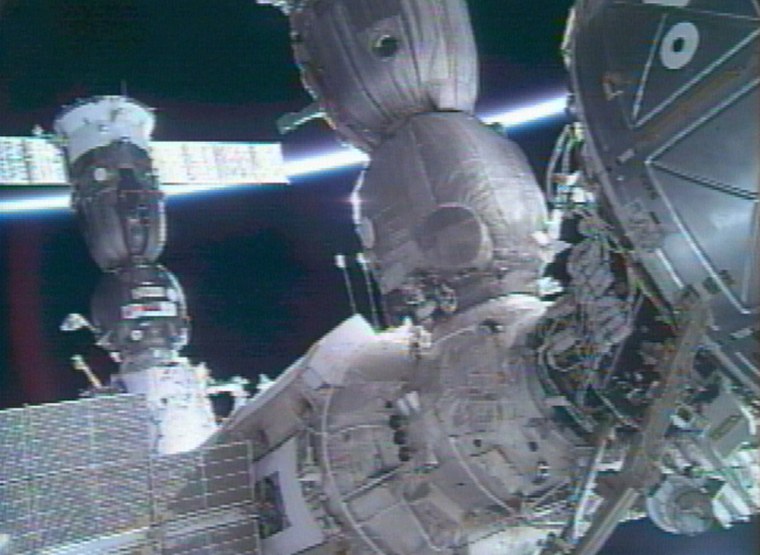A Soyuz spacecraft bearing the international space station's next crew closed in on the orbiting outpost at dangerously high speed Saturday, forcing the pilot to put on the brakes, abandon autopilot and manually dock the capsule in an unplanned and tricky maneuver.
It was a last-minute wrinkle for a crew that had never piloted a Soyuz before. The Soyuz TMA-5, carrying Russians Salizhan Sharipov and Yuri Shargin and American Leroy Chiao, approached the station so quickly that a danger signal was activated, prompting Mission Control’s order for the crew to go manual.
When the ship docked with the station at 8:16 a.m. Moscow time (12:16 a.m. ET), just more than 49 hours after lifting off from the Baikonur cosmodrome in Kazakhstan, cosmonauts and officials at the Mission Control in Korolyov, just outside Moscow, burst into applause.
“Everything went normally, even though we noted a higher speed, close to dangerous, but the crew acted brilliantly,” Mission Control chief Vladimir Solovyov said.
NASA Deputy Administrator Fred Gregory, who observed the docking from Korolyov, said the switch from automatic to manual mode was “seamless.”
“It appears that the crew was extremely well-trained,” he said.
Filling in for the shuttles
It was the fourth time a Soyuz has filled in for U.S. space shuttle flights, which were suspended since the Columbia burned up on re-entry in February 2003, killing all seven astronauts on board. The Soyuz is a workhorse of Russia’s cash-strapped space program and has a stellar safety record.
But no members of this crew had flown the spacecraft before, a rare departure from a long tradition of having at least one cosmonaut with previous Soyuz experience.
Space officials downplayed the lack of experience, saying Chiao and Sharipov flew on U.S. shuttles and insisting that the crew underwent sufficient training.
Soyuz spacecraft normally are guided by autopilot on their approach to the station and during the docking, but the crew is trained to operate the capsule manually in case of computer failure.
Not clear what caused glitch
Solovyov said the ship was braked and switched to manual controls just 660 feet (200 meters) away from the station.
“When the speed became significantly higher than normal, an onboard automatic system warned that the spacecraft were getting dangerously close,” Solovyov said. “The Mission Control decided to switch to manual mode.”
Yuri Semyonov, head of the Energia company that manufactures Soyuz spacecraft, said it was not immediately clear what caused the glitch in the automatic docking system and promised to investigate.
Replacement crew
Sharipov and Chiao will replace Russian Gennady Padalka and American Mike Fincke, who are ending a half-year mission on the orbiting station. Padalka and Fincke will return to Earth with Shargin on Oct. 24.
During their six-month mission, Sharipov and Chiao will conduct experiments to research new AIDS vaccines and study plant growth. They also will take at least two spacewalks.
The crewmen’s relatives expressed relief at the successful docking.
“We were very nervous,” said cosmonaut Shargin’s wife, Lyudmila Lutokhina. “This isn’t our first time seeing off a crew, but of course when it’s about the people you love, it’s a different kind of anxiety.”
Sharipov’s 16-year-old daughter, Nagira, and 12-year-old son, Dzhakhangir, also watched anxiously.
“I was very nervous this time. My mama and I didn’t sleep the whole night,” Nagira Sharipov said.
Crews embrace in space
About three hours after the docking, Padalka opened the hatch and embraced cosmonaut Sharipov, the first new crewman to enter the station. Chiao and Shargin followed.
On the ground, space officials wished the new crew a productive mission and the departing crew a safe journey back to Earth.
“Gennady, I see your hair has gotten too long,” Gregory quipped over the radio to Padalka. “It looks like you’re ready to go home.”
Russia and the United States completed negotiations on joint flights earlier this month, agreeing to work together through April 2006, Gregory said. Negotiations are under way for joint flights in 2006-2010, he said.
NASA scientists are evaluating the missions in response to Russia’s desire to send crews up for more than six months at a stretch, he said.
NASA had hoped its shuttles would be flying again by early spring, but hurricane damage in Florida pushed that target back to early summer.
